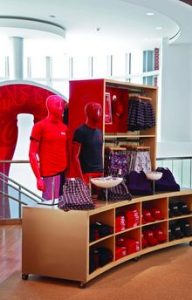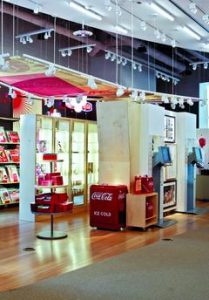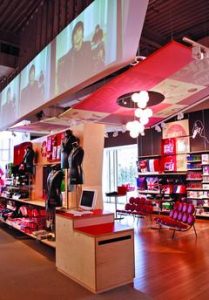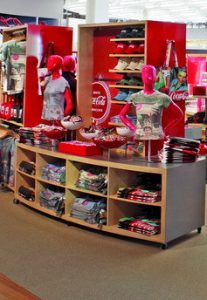The new World of Coca-Cola museum is a huge, $96 million undertaking that celebrates one of the world’s most identifiable brands, the iconic 122-year-old “real thing.”
For most people, coming to the World of Coke at Coca-Cola’s international headquarters in Atlanta is not a science project in learning how the company turns coca leaves and kola nuts into the world’s most popular drink. (Coke never has revealed the formula and probably never will.) Rather, it’s cozying up to a brand that has been a part of everyone’s lives. A big part of the experience is a display of the marketing materials we’ve all lived with: the shapes of the bottles, the changing logos, the ads and posters, movie clips and audio presentations, jingles and other symbols of Coke through the years.
But Coke doesn’t want this simply to be a bath of nostalgia. Rather, says Patrick Kells, Coca-Cola’s director of commercialization, the enterprise – and especially the retail space – is an attempt to show how contemporary and meaningful the company still is, to look forward while embracing the past.
“One of the goals was to stretch people’s thinking about Coca-Cola,” says Kells. “We want people to take away a feeling of optimism, energy, inspiration.”
The Coca-Cola Store at the end of the tour continues the message of the company as a forward-looking corporate citizen, a responsible resident of the earth and a relevant component of everyone’s life. For one thing, the store was designed to achieve gold certification from LEED (the Leadership in Energy and Environmental Design green building rating system), from the bamboo floors and recycled rubber floor mats to the use of plywood fixtures and fluorescent lighting. Even some of the merchandise follows the theme of the store, which is “Recycle. Repurpose.”
Advertisement
Messenger bags and CD cases are made of vinyl from old Coke billboards. Discarded bottle wrappers were turned into wallets. Recycled aluminum can tabs were hand-woven into purses. Plastic bottles were reclaimed, converted to fiber, blended with cotton and used to make T-shirts and totes. Glass bottles were broken up and set in sterling silver and are being sold as jewelry. “These are all things that would otherwise have ended up in landfills,” Kells says.
And the merchandise is not just of the traditional logotyped keychains-and-coffee-mugs variety. “Coke tried to look beyond the beverage and develop products that can connect to an active, cutting-edge psychographic that appreciates the culture of design,” says senior project manager Scott Faucheux of design firm Pompei A.D. (New York). Lifestyle merchandise – floor cushions, dinner plates, lamps, etc. – is more noteworthy for the inspiration of London-based designer Zakee Shariff or Los Angeles-based Studio Espinosa than for any association with the brand. “The message is ‘harmony, peace, a better tomorrow,’ ” Kells says.
The intermittent use of familiar Coke icons is meant to be “continually surprising,” says Kelly Kozel, senior design manager brand/retail stories. “It was as important for us to communicate the genuine and authentic side of our brand as it was to create a space that provides a platform for new products.The products and the visual merchandising in the store reflect the intent to be an agent of what’s new and engaging.”
To make sure that message is heard, store planners had to slow the crowd down. Traditional “exit retail” tends to be a rushed experience – souvenir-shopping on the way out the door. So the designers grappled with how to flow an expected 6000 visitors a day through the 9000-square-foot space without overwhelming them, giving them opportunities to stop and browse. Pompei’s solution was a semi-circular racetrack aisle pattern with intermittent pavilions to allow people to get out of the flow and check things out.
One pavilion focuses on specially designed lifestyle goods – clothing, picnic items, home goods, barware. Another focuses on collectibles – artwork and rare items, like pins and posters from the 1962 World’s Fair in Seattle. But Pompei A.D.’s Faucheux emphasizes that the merchandise is less about collecting than about using. “Memorabilia make up only 10 to 15 percent of the merchandise offering,” he says. “Coke wanted relevant, useful merchandise that meshed with the community.”
A third pavilion is aimed directly at the younger consumer. It’s a lounge filled with computer terminals, TV sets and couches. Visitors can go online, play video games or visit a special Coke web site. “Collectors can shop,” says David MacConnie, Coca-Cola’s visual manager, retail and attractions, “while younger visitors can relate to the brand in a fun, meaningful way.”
Advertisement
A cloud suspended from the ceiling makes the huge space more intimate and reinforces the circular traffic flow. And long, parallel lines of fluorescent tubes point toward the cashwrap and exit.
The perimeter of the store was painted to match the dark brown syrup of the drink. And some of the cabinets emulate the brand’s familiar red and white palette. But most of the fixturing is neutral. And there are no graphics or overlays that shout “Coke,” except for the printed cloth over the pavilions bearing subtle variations of different Coke graphics.
The fixtures were designed to enhance flexibility and durability. The plywood fixtures were clad with raw steel that was chemically washed to simulate sandblasting. “With the expected high volume of traffic, Coke wanted to protect against the fixtures getting beaten up,” says Jonathan Glanz of J. Glanz Associates (Ho-Ho-Kus, N.J.), who coordinated the fixture program and sourced all the manufacturers. “If it gets scratched or dinged, it looks like an intentional part of the patina.”
Modularity in the wall system and a socket system in the loose fixturing allowed for maximum versatility. “We wanted to make sure the store never looked dated,” says MacConnie, “that there wasn’t any element we couldn’t easily and efficiently change out as we strive to remain timely.”
“We delivered the store to be an extension of the attraction experience,” says Linda Conrad, general manager, Coca-Cola retail and attractions, “and by all accounts, guests are seeing it that way.”
So try to ignore the cuddly polar bears. Coke has its eye on the future.
Advertisement
The Coca-Cola Store (right), part of the new World of Coca-Cola museum in Atlanta, uses lighting and shapes to create what it hopes will be a compelling Coke experience with iconic memorabilia and newly designed merchandise. The store’s entrance at the end of the tour (above) is expected to attract 6000 visitors a day.
CLIENT
Coca-Cola Co., Atlanta
Linda Conrad, general manager, Coca-Cola retail and attractions
Patrick Kells, director of commercialization, worldwide licensing
Kelly Kozel, senior design manager brand/retail stories
David MacConnie, visual manager, retail and attractions
Nathan Facteau, assistant creative manager, retail and attractions
DESIGN
Pompei A.D. LLC, New York
Colin Brice, executive director of design
Scott Faucheux, designer & senior project manager
Drew Lytle, design team
Aylin Cinarli, design team
David Ostow, design team
Monte Antrim, design team
ARCHITECT
Rosser Intl., Atlanta
GENERAL CONTRACTOR
Holder-Manhattan-Moody, Atlanta
PROGRAM MANAGER
Jones Lang LaSalle, Atlanta
LIGHTING
Johnson Light Studio, New York
AUDIO/VISUAL
DMX Music, Austin, Texas
Electronic Systems Inc,, Orlando
FIXTURES
J. Glanz Associates, Ho-Ho-Kus, N.J.
MG Concepts, Central Islip, N.Y.
Sincerely Intl., Hong Kong
FLOORING
Commercial Flooring Services/HPI, Fayetteville, Ga.
FURNITURE
Quinze & Milan, Bronx, N.Y.
MANNEQUINS/FORMS
Goldsmith Inc., Long Island City, N.Y.
Seven Continents, Toronto
PROPS AND DECORATIVES
Creative Design and Development, Sanford, Fla.
Greneker Solutions, Los Angeles
RAP Store Fixtures, Cudahy, Calif.
Seven Continents, Toronto
Visual Designs and Sources, Valrico, Calif.
SIGNAGE/GRAPHICS
Promoworks, Lawrenceville, Ga.
Seven Continents, Toronto
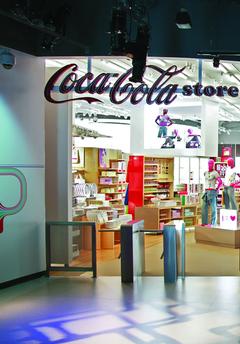

 Headlines2 weeks ago
Headlines2 weeks ago
 Headlines1 week ago
Headlines1 week ago
 Headlines2 weeks ago
Headlines2 weeks ago
 Headlines5 days ago
Headlines5 days ago
 Headlines1 week ago
Headlines1 week ago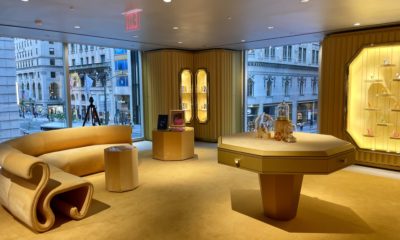
 Eric Feigenbaum3 days ago
Eric Feigenbaum3 days ago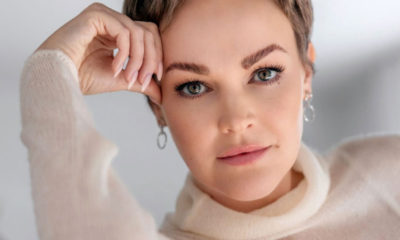
 Designer Dozen1 week ago
Designer Dozen1 week ago

